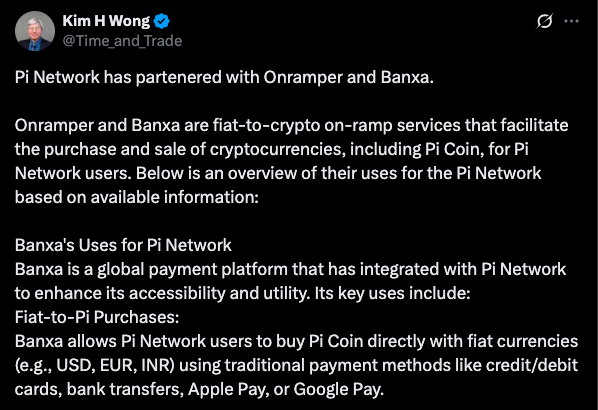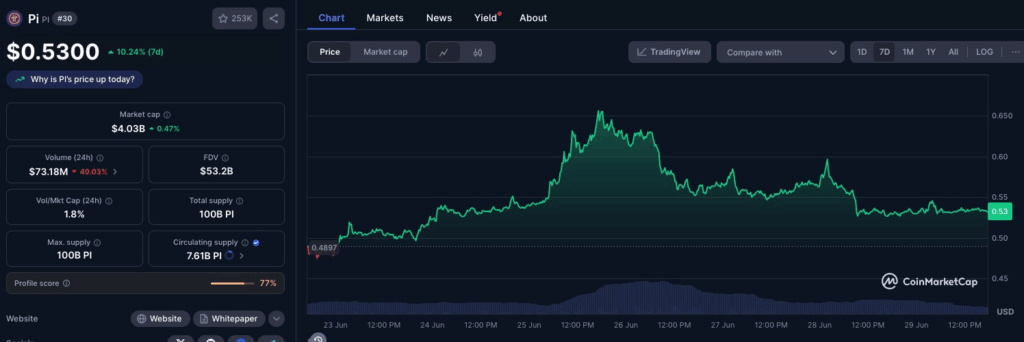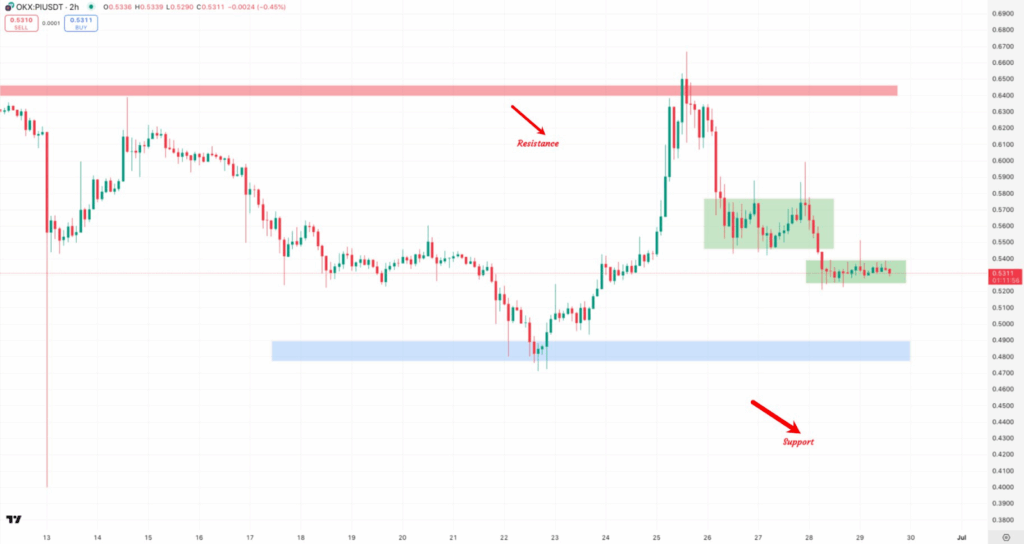Key Insights:
- Pi Network Deepens Accessibility via Banxa and Onramper
- Banxa Enhances Utility Through Liquidity and Wallet Activation
- The current Pi Crypto Value Holds Support After Failed Breakout at $0.66
Pi Network has also revealed its partnership with Banxa and Onramper, giving a positive outlook on the Pi crypto value.
The partnership involves fiat-to-crypto gateways to offer direct transactions of Pi Coin with the help of traditional payment methods.
The announcement coincides with the objective of Pi Network preparing to be used within popular culture by introducing some degree of connection between the decentralized worlds and the mainstream financial entities.

The Banxa integration will provide users in more than 100 countries the option to purchase Pi Coins with fiat currencies like USD, EUR, and INR. It accepts different means of payment such as Apple Pay, Google Pay, and bank transfer.
The collaboration eliminates the challenges related to intermediate conversions and exposes access to millions of prospective consumers who have never used crypto platforms.
Banxa is also supportive of off-ramping, which allows Banxa users to sell Pi Coin directly into fiat and have it deposited into their bank accounts, abolishing the vital use of tokens in the real world.
The Pi Crypto Value Finds Support After Retreat From Resistance
Amid the news, the Pi crypto value on June 29 stands at 0.5300, an increase of 10.24% in the last week. The market capitalization is about $4.03 billion, and there are 7.61 billion PI circulating in the market with a total supply of 100 billion.
During the 24-hour block, the trading volume decreased significantly by 49.03% to reach $73.18 million, with the 7-day performance generating a positive picture.

According to the graph on CoinMarketCap, the price increased by almost 25 percent ($0.49 to $0.66) in a span of only three days between June 23 and 26 and then fell back. This action returned Pi to a temporary consolidation area around $0.52-$0.54.
Pi Crypto Value Under Tight Consolidation
Looking at 2-hour charts, we see evident support at the range of $0.4345, where a number of rebounds occurred in the middle of June.
The level was flipped as price action on June 23 led to an aggressive rally and the formation of a sharp top at the resistance level of $0.65- $0.66.
This area has declined price action numerous times in the past, so there is heavy overhead selling pressure at this zone.
A distribution segment transpired at the lower limit of $0.56 to the higher level of $0.59 after the high.
This range indicated a lack of excesses in prices as indicated by narrower candle sizes and longer wicks, an indication of indecisive price action and sell-side dominance.
As the distribution was settled, the asset dropped into a secondary consolidation box of $0.52 to 0.54, where it is trading at present, exhibiting low volatility.

The general rule looks like an abortive breakout with stabilization. Volume data backs this conclusion. A 49% drop followed the price increase in trading volume, which is a sign of losing steam or having fewer hands in the game after the pump.
Nevertheless, trading volume statistics are 7.61 billion tokens out of 100 billion, meaning an insignificant percentage of the coin is circulating, which is a contributing factor to possible turbulence.
The price of the token is also structurally limited by the resistance band of the price range below the mark of $0.66, and lower highs have formed since the June 26 peak.
Although the near-term support level is around the $0.53 level, its eventual failure might bring Pi back to the previous level around the $0.49 or even the broader range around the $0.43 and the $0.45.
